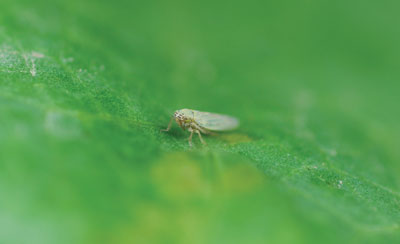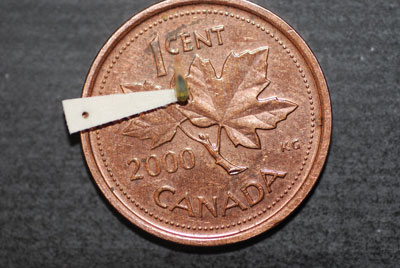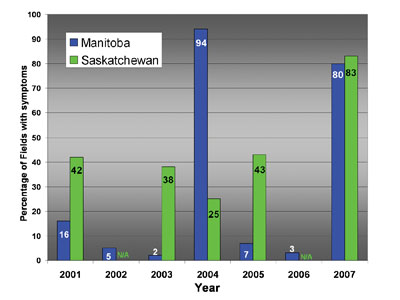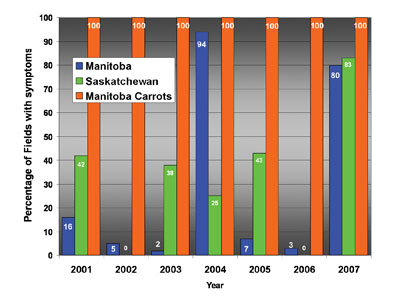
Features
Seed & Chemical
Seed Treatment
Aster yellows: symptoms, management and agronomic considerations
Aster yellows (AY), which is very challenging and difficult to predict, is a viral-like disease that is caused by a phytoplasma and spread primarily by aster leafhoppers.
March 17, 2009 By Donna Fleury
Aster yellows (AY), which is very challenging and difficult to predict, is a viral-like disease that is caused by a phytoplasma and spread primarily by aster leafhoppers. The AY phytoplasma, present across Canada and around the world, is a single celled prokaryotic microorganism, lacking a cell wall and capable of inciting disease in more than 300 plant species, including a wide range of crops and weeds.
 |
|
| A close-up of an aster leafhopper. |
The leafhoppers, which are phloem feeders, acquire the phytoplasma by feeding on infected plants. The phytoplasma can reproduce within the tissues of the leafhopper and the host plant. They then transmit the phytoplasma to healthy plants causing the disease to develop. Phytoplasmas cause severe symptoms, such as yellowing, phyllody (leaf-like petals and sepals), stunting, proliferation and witches’ broom, and yield losses in a variety of economically important crops. “There is no practical way of controlling the phytoplasma, therefore the leafhopper vector must be managed in high value crops,” explains Dr. Philip Northover, plant pathologist with Manitoba Agriculture, Food and Rural Initiatives. “Once a plant is infected, there is no effective treatment.”
Vegetable crops typically suffer the greatest damage from aster yellows, resulting in reduced quality, unmarketable appearance and the unpalatable taste caused by the infection. “Aster yellows make carrots taste very bitter, leaving a bad taste you will never forget,” says Northover. “Carrots have a low economic threshold for leafhopper populations and are used as the indicator crop, because when they get infected it is usually very serious.”
Field crops including oilseeds, cereals and forages also serve as hosts. Due to the low economic threshold for leafhopper populations, carrots are the first crops that entomologists sweep for leafhoppers, along with nearby cereal fields.
 |
|
| A size comparison of aster leafhopper to a penny. Photos courtesy of Brent Elliot, Manitoba Agriculture, Food and Rural Initiatives. |
In 2007, aster yellows was observed in a wide range of crops in Manitoba, raising concerns among many growers. A survey of canola fields in 2007 showed aster yellows levels at 80 percent of fields compared to 3 percent in 2006. In 2007, aster leafhoppers in Manitoba carrot fields reached levels that were seven times that of 2006. “Another really bad year was 2004, with high levels of aster yellows in crops like canola and cereals, which mostly went unnoticed,” says Northover. “There is no guarantee that a region that had aster yellows in an annual crop one year will have the same or an increased level of symptomatic plants the following year.”
However, in 2008 there was a complete reversal to 2007. “We found virtually no leafhoppers in 2008, and the expression of symptoms have been at the lowest levels in years,” says Northover. “The most likely explanation is the weather during the 2008 growing season, which saw few southerly winds to carry migratory leafhoppers into Manitoba and Saskatchewan and a cooler start to the summer.” In 2007, there was an extended hot period over the growing season and there were a lot of southerly winds carrying up multiple populations of leafhoppers.
 |
|
| Graph 1: Percentage of canola fields with symptoms of aster yellows in Manitoba and Saskachewan for 2001 to 2007. Due to drought conditions there was no Saskatchewan survey in 2002. Manitoba and Saskatchewan canola AY data are taken from the Canadian Plant Disease Survey (McLaren et al. and Pearse et al. volumes 82-87). |
 |
|
| Graph 2: Percentage of canola fields with symptoms of aster yellows in Manitoba and Saskatchewan for 2001 to 2007 compared to the outbreaks in Manitoba carrot fields in the same time period. Due to drought conditions there was no Saskatchewan survey in 2002. Manitoba and Saskatchewan canola AY data are taken from the Canadian Plant Disease Survey (McLaren et al. and Pearse et al. volumes 82-87). The carrot data is from the Manitoba Weekly Vegetable Report website. |
Managing aster yellows
Diagnosing aster yellows can be difficult on many field crops and virtually impossible to distinguish from other problems in the field, requiring specialized lab techniques. Visual symptoms in many field crops, especially in cereals, can easily be confused with other crop problems such as stress responses, nutrient deficiencies or herbicide damage. “Recent work in Minnesota shows cereal diseases first diagnosed as barley yellow dwarf disease may actually be aster yellows,” says Northover. “This is something relatively new and we’re trying to determine how to approach the problem here.”
Aster yellows can impact yields in canola and cereal crops, but usually at relatively low levels. The disease affects flower production and ultimately the number of seeds produced. “With canola, infected plants often stand up higher than the rest of the crop and foliage can turn a reddish color,” explains Northover. “The disease can cause the flowers to develop into deformed leafy structures, rather than pods or seed heads.” These plants are often more noticeable and may give the perception that the level of disease is far greater than it actually is. In most cases, leafhoppers prefer to feed on other plants before canola, so it is rarely an economic problem.
Cereals are probably a better host for the AY phystoplasma than canola, but the symptoms are not as dramatic in canola and the disease rarely gets noticed.
Aster leafhopper has a wide range of hosts, including several common weeds such as plantain, dandelion, and sow thistle. “Therefore, managing weeds will help, but it won’t eliminate the problem,” says Northover. Crop rotation is ineffective for aster yellows management due to this wide range of phytoplasma hosts, and the annual migratory populations that come up from the south. “However, seeding as early as possible is a good strategy because leafhoppers generally don’t arrive in Manitoba until late June or early July.”
Similar to other pests, the younger the crop the greater the damage and impact from leafhoppers. “Perennial grasses and forages also serve as a host for the phytoplasmas, and they can survive in the plant for as long as the stand is growing, although there may not be a great reduction in yield,” says Northover.
“However, if you plant a canola crop next to the alfalfa or forage grass that has been infected over the years with multiple generations of the phytoplasma, you could have severe disease problems in canola even with low levels of leafhoppers.” This level of disease is not usually typical for canola planted in other locations. Therefore, it is best to avoid planting canola next to alfalfa or other perennial forages to reduce the risk of high disease losses in other crops.
“The unpredictability of annual leafhopper populations poses a lot of problems for management because we’re relying on guesswork as to whether or not it will be a bad year,” explains Northover. “The multiple generations within a season, combined with migratory leafhopper populations would require multiple applications of chemical control. Once you see the symptoms, nothing will undo the problem.”
In carrot production, aster yellows is an annual problem and of considerable concern. The high value of the carrot crop relative to most field crops make leaf hopper management an economic strategy. Dimethoate (CygonTM or Lagon®) is the only active ingredient registered for aster leafhopper control in canola, however the economics rarely justify an insecticide application. “In many cases there will be zero economic benefit to doing so,” explains Northover. “Management of the aster leafhopper and aster yellows with chemical means is currently impractical for canola and other field crops.”